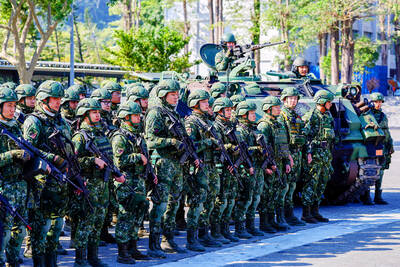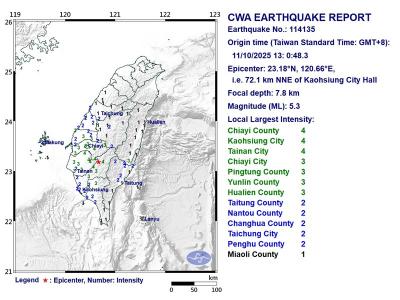The Czech Republic’s experience in making high-end instruments and assisting European Space Agency (ESA) missions makes Prague and Taipei complementary partners in the field of aerospace, especially as Taiwan aims to develop scientific instruments for a lunar orbiter, Taiwanese scientists say.
While the US and France have been the nation’s major foreign partners in space technology development over the past three decades, a Czech delegation’s visit to Taiwan last week might usher in new opportunities.
The National Space Organization (NSPO) plans to sign memorandums of understanding with the Czech Academy of Sciences’ (CAS) Institute of Atmospheric Physics, Charles University’s Faculty of Mathematics and Physics, and the Czech Technical University in Prague’s Institute of Experimental and Applied Physics.

Photo courtesy of National Central University Department of Space Science and Engineering
It is the first time that the NSPO plans to sign such agreements with Czech institutions, while individual Taiwanese and Czech scientists have sustained ties for years.
Taiwan’s world-leading research on ionospheric observations is appealing for Czech scientists, while their high-end engineering technology cultivated during the former Soviet Union is valuable for Taiwan, said Liu Jann-yenq (劉正彥), a professor at National Central University (NCU) department of space science and engineering.
His team has worked with the Institute of Atmospheric Physics under the CAS for nearly eight years, said Liu, who is also a member of the Central Europe Task Force at the Ministry of Science and Technology’s Center for Global Affairs and Science Engagement.
The team has developed a network of ionospheric observation stations using high-frequency Doppler sounders deployed in Hsinchu, Miaoli, Chiayi, Nantou, Yilan, Hualien and Taitung counties, he said.
The sounders transmit and receive radio signals to analyze ionospheric disruptions, which can influence radio communications and global positioning systems on Earth, he said.
Taiwan and the Czech Republic are also looking forward to more cooperation in the development of artificial satellites, he said.
The department in December plans to launch a cubesat for ionospheric observations, he added.
The Ionospheric Dynamics Explorer and Attitude Subsystem Satellite (IDEASSat) weighs nearly 4.5kg and has been completely developed, manufactured, and assembled by the department’s faculty and students, he said.
His team would share the data collected by IDEASSat with their Czech collaborators, as they can help download and analyze them, he said.
The cubesat would be launched by US company SpaceX on a rideshare launch brokered by ISILaunch in the Netherlands and HelioX Cosmos in Taiwan, a project funded by the NSPO, he added.
Other Taiwanese and Czech researchers are working on proposals to develop scientific payloads on a spacecraft that would orbit the moon, a mission announced by the NSPO.
The NSPO earlier this year made a call soliciting scientific payloads to be installed on a lunar orbiter as part of the nation’s third space technology development program, which began last year and would run through 2028.
The payloads can weigh up to 3kg and need to withstand drastic radiation and temperature changes during the cislunar cruise and in lunar orbit, and the flight models of the payloads would be delivered by the first quarter of 2024, according to an NSPO announcement last month.
The spacecraft, with a planned dry mass of 150kg, would be sent to an orbit 100km above the moon, the announcement said, without naming the maker of the spacecraft.
Asked about the NSPO’s call, department director Chao Chi-kuang (趙吉光) said the department plans to develop an instrument to measure electromagnetic parameters on the lunar surface to deepen scientists’ understanding of the moon’s mantle.
Chao’s team has developed an Advanced Ionospheric Probe that was installed on Taiwan’s own Formosat-5 satellite, which was launched on a SpaceX Falcon 9 in 2017.
The department also aims to work with Charles University to develop an instrument to measure solar particles, he said.
Chao said he initially had reservations about the NSPO’s call, given Taiwan’s lack of experience in making instruments that can resist higher cosmic radiation outside the Earth’s magnetic field.
Nonetheless, he became more interested in it after building ties with Charles University, Chao said.
While the Czech Republic does not have a national agency similar to the NSPO, its Czech Space Alliance — an association of aerospace firms — is part of the ESA supply chain and has more experience in making instruments to explore other planets, he said.
Deepening ties with Czech institutions and the country’s space industry would allow Taiwan to save time on lunar exploration, as it attempts to move from Earth-centered observations to missions targeting other planets, Chao said.
The moon’s rich reserves of helium-3, a potential nuclear fuel, are worth investigating, and the moon can be regarded as a logistics station for missions to Mars, he added.
Gilbert Pi (畢可為), an NCU graduate working at Charles University’s Faculty of Mathematics and Physics, helped connect NCU and the NSPO to the faculty.
Pi said he had visited Prague several times while studying under his NCU adviser Shue Jih-hong (許志浤), who maintains close ties with the Czech faculty.
Having become a project researcher there after three years of postdoctoral research, Pi said he enjoys being part of the Space Physics Group led by professor Zdenek Nemecek, adding that he is the only non-European member of the team.
Their group has developed instruments for missions led by the ESA and Russia, and is glad to share its experience with Taiwan, he said.
Taiwan’s third space program also attracts many Czech institutions, he added.
In addition to the moon exploration project, Taiwan’s third space program also involves the development of six high-resolution optical remote sensing satellites, two super-high-resolution remote sensing satellites and two synthetic aperture radar satellites.
Professor Loren Chang (張起維) said he represented the department last week in a meeting with the members of the Czech Space Alliance at a trade forum during their visit to Taiwan with Czech Senate President Milos Vystrcil.
Some Czech companies specializing in satellite navigation systems or infrared sensors have expressed an interest in the department’s satellite development as well as research on the impact of ionospheric disruptions on communications, Chang said.
Asked about the lunar exploration project, Deputy Minister of Science and Technology Shieh Dar-bin (謝達斌) said a major hurdle is the loss of satellite or spacecraft communications on the far side of the moon, so advancing communications, materials, engine combustion and autocontrol technologies would be necessary to develop a lunar orbiter.
The ministry could help gather experts for the NSPO’s lunar exploration project, while foreign resources, such as a planned SpaceX lunar lander, would be part of its considerations as well, he said.

The Central Weather Administration (CWA) today issued a sea warning for Typhoon Fung-wong effective from 5:30pm, while local governments canceled school and work for tomorrow. A land warning is expected to be issued tomorrow morning before it is expected to make landfall on Wednesday, the agency said. Taoyuan, and well as Yilan, Hualien and Penghu counties canceled work and school for tomorrow, as well as mountainous district of Taipei and New Taipei City. For updated information on closures, please visit the Directorate-General of Personnel Administration Web site. As of 5pm today, Fung-wong was about 490km south-southwest of Oluanpi (鵝鑾鼻), Taiwan's southernmost point.

Almost a quarter of volunteer soldiers who signed up from 2021 to last year have sought early discharge, the Legislative Yuan’s Budget Center said in a report. The report said that 12,884 of 52,674 people who volunteered in the period had sought an early exit from the military, returning NT$895.96 million (US$28.86 million) to the government. In 2021, there was a 105.34 percent rise in the volunteer recruitment rate, but the number has steadily declined since then, missing recruitment targets, the Chinese-language United Daily News said, citing the report. In 2021, only 521 volunteers dropped out of the military, the report said, citing

A magnitude 5.3 earthquake struck Kaohsiung at 1pm today, the Central Weather Administration said. The epicenter was in Jiasian District (甲仙), 72.1km north-northeast of Kaohsiung City Hall, at a depth of 7.8km, agency data showed. There were no immediate reports of damage. The earthquake's intensity, which gauges the actual effects of a temblor, was highest in Kaohsiung and Tainan, where it measured a 4 on Taiwan's seven-tier intensity scale. It also measured a 3 in parts of Chiayi City, as well as Pingtung, Yunlin and Hualien counties, data showed.

Nearly 5 million people have signed up to receive the government’s NT$10,000 (US$322) universal cash handout since registration opened on Wednesday last week, with deposits expected to begin tomorrow, the Ministry of Finance said yesterday. After a staggered sign-up last week — based on the final digit of the applicant’s national ID or Alien Resident Certificate number — online registration is open to all eligible Taiwanese nationals, foreign permanent residents and spouses of Taiwanese nationals. Banks are expected to start issuing deposits from 6pm today, the ministry said. Those who completed registration by yesterday are expected to receive their NT$10,000 tomorrow, National Treasury